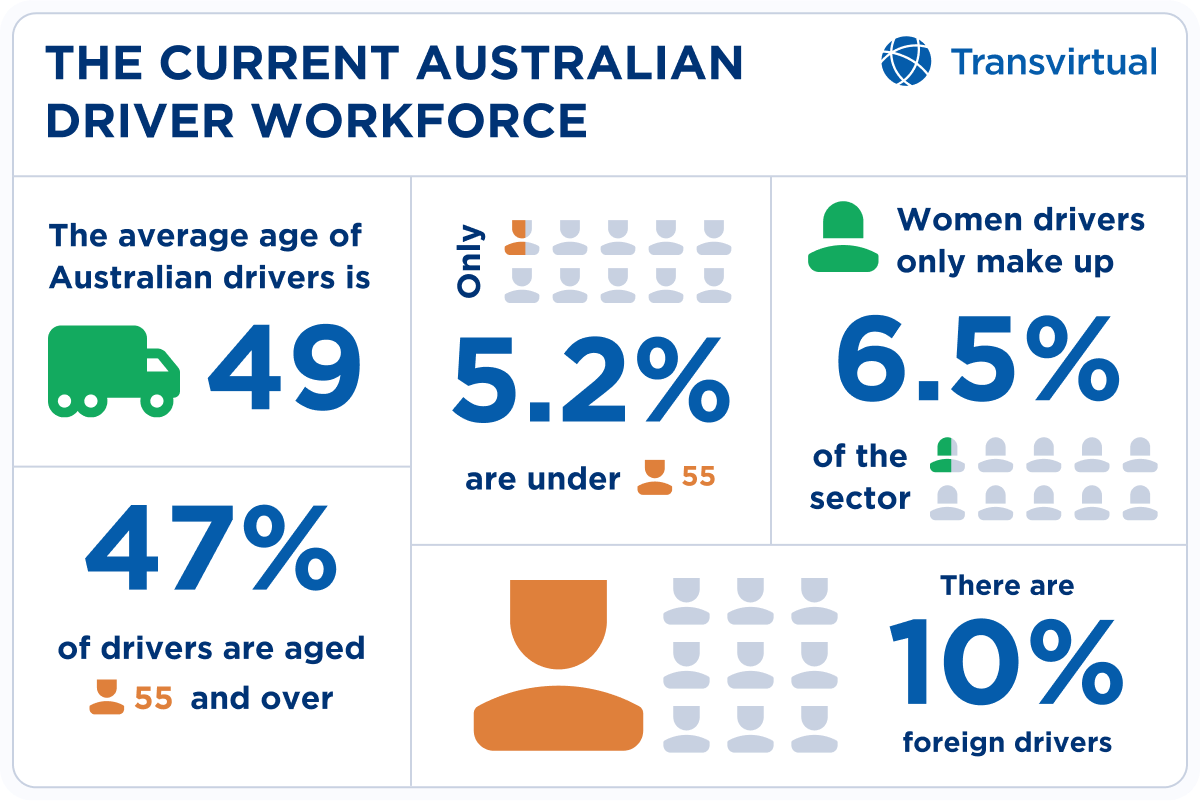Table of Contents
The driver shortage in Australia has been a persistent issue in recent years. But now, it’s reaching crisis levels. With thousands of unfulfilled driver roles, the impact echoes everywhere. This shortage is not just a burden for trucking companies. It also affects retailers, manufacturers, and everyday consumers who rely on goods arriving on time.
So, what’s behind this shortfall? And more importantly, what needs to be done?
Let’s break down the latest figures in Australia’s driver shortage, explore the root causes, and highlight its consequences for supply chains and the economy.
Empty Wheels: What’s Causing the Driver Shortage?
Australia’s driver shortage is a result of long-standing industry challenges that have reached their tipping point.
Aging Drivers
Australia’s record show that 47% of its truck drivers are already over 55 years old. And by 2029, 21% of its current truck drivers will retire by 2029.
Many experienced drivers are nearing retirement. Unfortunately, there aren’t enough young drivers to fill the gap. As the age divide widens, the industry is facing an alarming talent drain.
Lack of New Driver Recruitment
Recruiting new talent has become increasingly challenging. In fact, 44% to 70% of trucking operators are having severe difficulties in attracting fresh drivers. Younger generations often see trucking as a tough, isolating job with long hours and little work-life balance, which isn’t far from the truth.
Fatigue, Burnout, and Health Issues
The tough working conditions and the risk of fatality add to the reasons why driver recruitment is low. Fatigue is a serious issue in trucking. Long hours on the road, tight delivery windows, and little rest can take a toll.
In Australia, 1 in 5 truck drivers below 35 report severe psychological stress. The majority of them also carry concerning health problems, including:
Obesity (54.3%)
Three or more chronic conditions (29.5)
Chronic pain (44%)
Poor general health (29.9%)
It’s easy to see why many leave the profession early or avoid it entirely.
Training and Licensing Barriers
To get a heavy vehicle licence in Australia, learners must pass a heavy vehicle knowledge test, complete a medical test (in many states), and then take on practical training, often over one or two days with a Registered Training Organisation (RTO). Depending on the licence class (Heavy Rigid, Heavy Combination, or Multi Combination), costs can range anywhere from $900 to over $2,300, including assessments and government fees.
For many would-be drivers, that’s a big investment just to get started.
The licensing system varies between states. In some cases, learners need to hold a lower-class licence for 12 months before they can even apply for a heavy vehicle upgrade. That adds another layer of delay and complexity.
The long process can discourage even the most motivated aspiring drivers. It’s also clear why the industry can’t attract younger drivers who may not have the support, savings, and time to go through the process.
State of Driver Shortage: An Outlook
Unfulfilled Slots
Across 36 countries, the number of unfilled truck driver positions has surged to 3.6 million. In Australia alone, the current shortfall sits at almost 28,000 vacant roles, a figure that continues to rise year after year.
Projected Shortfall
The years ahead aren’t promising for the industry. Globally, an estimated 3.4 million drivers are expected to retire by 2029. In Australia, 21% of the current driver workforce is approaching retirement age. The shortfall could balloon to 78,000 by 2029 if no action is taken.
Today’s Drivers
Here’s a demographic breakdown of Australia’s current driver workforce:

The aging workforce, lack of young recruits, and limited diversity make it harder to close the widening gap.
Turnover Rates
Interestingly, drivers tend to be among the least likely to switch jobs. According to the Australian Bureau of Statistics, the Drivers and Machine Operators group reported the biggest decline in job mobility, from 11.9% in 2023 to 7.9% in 2024.
The same source shows that workers ages 45 to 54 only have a 5.3% turnover rate compared to the 12.6% of the 15 to 24 age group. This shows a clear link between age and job stability.
While an aging workforce is the major driver of the current driver shortage, there’s a silver lining—it also brings greater stability. Older workers tend to stay in their roles longer, which helps reduce turnover and maintain continuity across the industry.
Significant Impacts of the Driver Shortage Crisis
The National Road Transport Association (NRTA) describes the shortage as a “ticking timebomb” that could blow anytime. And it’s not only the transport industry that will bear the brunt. It’s a growing national concern for businesses and communities in real and costly ways.
Supply chain delays
Australia’s road freight is projected to grow by 77% from 2020 to 2050. Growth means more demand and if the shortage continues, this growth is going to be a curse.
Fewer drivers mean fewer trucks on the road. Goods take longer to reach distribution centres, shelves stay empty longer, and businesses scramble to meet customer expectations.
Increased shipping costs
When capacity is tight, freight prices go up. Businesses need to pay more to move the same volume of goods, and those rising costs are often passed down to retailers and eventually to consumers. From groceries to electronics, almost everything becomes more expensive when trucks aren’t moving efficiently.
Warehouse overstock and missed delivery windows
Unreliable transport means warehouses either overstock to play it safe or run dangerously low when deliveries fall through. Either way, it disrupts planning, increases storage costs, and risks customer dissatisfaction. Missed delivery windows lead to canceled contracts, spoiled goods, or unnecessary penalties.
Food and medicine logistics challenges
Timely deliveries are critical when dealing with perishable goods and medical supplies. Without enough drivers, fresh produce won’t make it to stores in peak condition. Medicines and vaccines, which require controlled environments, are especially vulnerable to delays.
Impact on small and rural communities
For small towns that rely heavily on road transport, the shortage can mean limited access to necessities. When there aren’t enough drivers to service less-populated routes, these communities face longer wait times, fewer deliveries, and increased costs.
Driver Shortage Solutions: What’s Already Working
Fortunately, the driver shortage crisis is not a neglected issue. Many are stepping up with smart, real-world solutions to get people behind the wheel and maintain the efficiency of road transport. Here are what’s already making a difference:
Better wages and benefits
Data debunks salary as one of the reasons why driver shortages are rising. In fact, the average truck driver earns 30 to 135% higher than the basic cost of living across all regions.
In Australia, a new truck driver earns more than $60,000 and can go up to $85,000 yearly. The figure increases by as much as $135,000 for interstate truck drivers.
Hiring from underrepresented groups
The industry is now focusing on inclusion, actively welcoming women, immigrants, young drivers, and candidates from diverse backgrounds.
The Australian Trucking Association (ATA) launched the InRoads and Diversity Program to bolster the country’s trucking workforce through inclusive recruitment. The program offers tools, training, and tailored support for employers looking to build a more inclusive workplace culture—something that’s essential for addressing the current driver shortage.
Partnerships with training schools and driver programs
Australia already has a national truck driving apprenticeship, finally recognising truck driving as a formal apprenticeship pathway. Supported by the Australian Government, state, and territory Skills Ministers, the program addresses workforce shortages and makes truck driving a more accessible and professional career.
This year, ATA called the Australian political parties to financially support apprentices, truck driver trainees, and employers. They proposed apprentices get $5,000 during their apprenticeship. For employers, they should receive $2,000 after 6 months and an added $3,000 after 12 months.
Fast-tracking licensing and onboarding
Industry push is underway to reform licensing requirements, reduce red tape, and remove time barriers. This is included in NRTA’s National Road Freight Workforce Action Plan.
Currently, the system leans too heavily on time-based licensing. But just because a driver has held a licence for a certain period doesn’t mean they’re truly ready for the complexities of operating a heavy vehicle on Australian roads. The industry is calling for a shift toward a competency-based model, where drivers are assessed on skills and real-world performance.
NRTA wants a nationally consistent licencing and training framework focused on practical, outcome-based learning.
How Technology Can Help
Technology can never make up for the growing driver shortage, but it can help ease the pressing load. It can help improve how freight moves and how businesses operate. For the drivers, it makes their jobs easier, safer, and more efficient.
Here’s how the right tools can make a difference.
Route optimisation and telematics
Modern GPS and telematics systems help drivers avoid traffic, reduce idle time, and plan fuel-efficient routes. For fleet operators, route optimisation tools also offer real-time visibility of vehicle locations, helping improve delivery accuracy and reduce delays.
Driver-assist technology
Driver-assist systems make a significant impact. Features like lane-keeping assistance, adaptive cruise control, fatigue detection, and collision alerts reduce the physical and mental strain on drivers. These tools help make the job safer and less tiring, especially during long hauls.
Load matching platforms and smarter dispatching
Platforms that use real-time data to match available drivers with freight loads are streamlining dispatch processes and reducing downtime. A bulk planning module ensures trucks are fully loaded and routes are well-planned to maximise productivity and improve driver utilisation.
Digital paperwork and admin reduction
Nobody gets into trucking for the paperwork. With the rise of mobile apps and cloud platforms, more transport companies are ditching the clipboards and switching to digital logbooks, timesheets, and delivery confirmations.
Many transport businesses now use electronic proof of deliveries (ePODs) and calculate service costs through automated rate cards. Less admin means more time on the road and fewer errors or delays caused by lost documents.
Keep Driving Forward
The driver shortage has been plaguing the transport industry for the past few years. Fortunately, the crisis isn’t unfixable. Solving this requires everyone’s participation.
Logistics professionals should start auditing their recruitment, training, and retention strategies. For policymakers, reform is long overdue. They need to review licensing pathways, training standards, and barriers holding back potential talent.
The road ahead won’t be easy. But with the right policies and stakeholders working together, the gap will be filled in no time.

